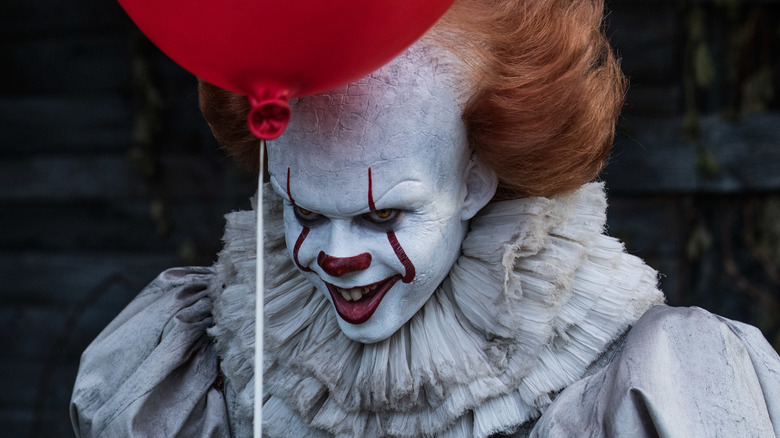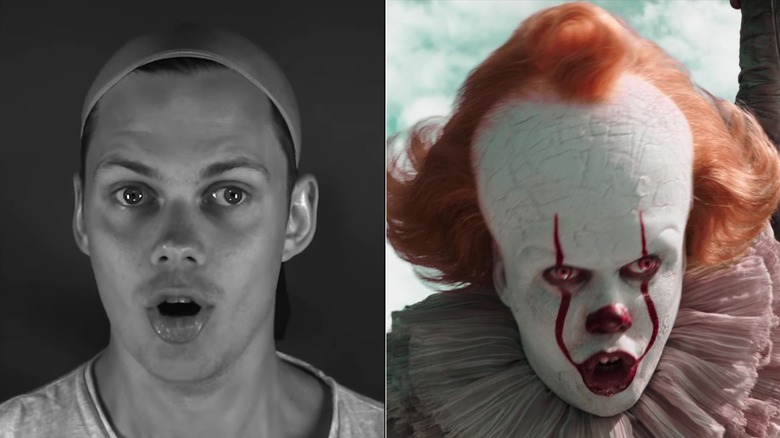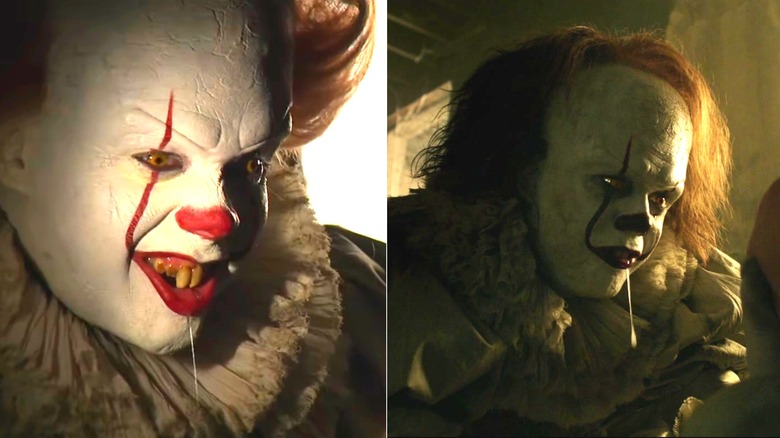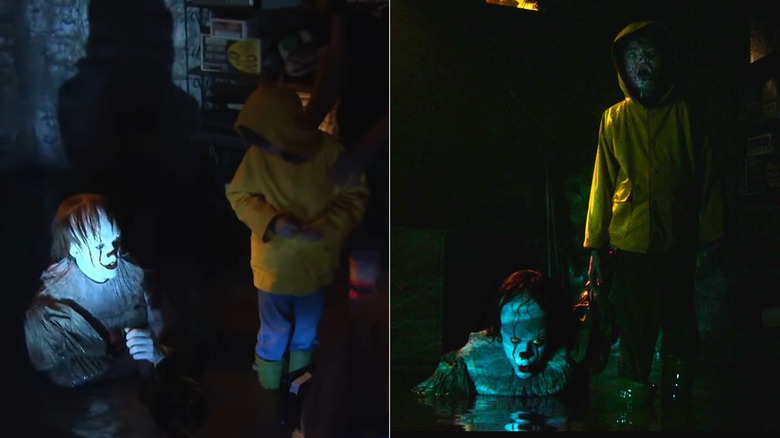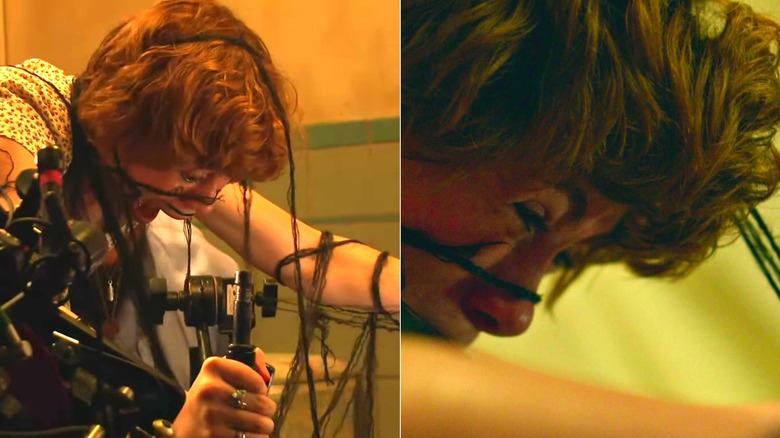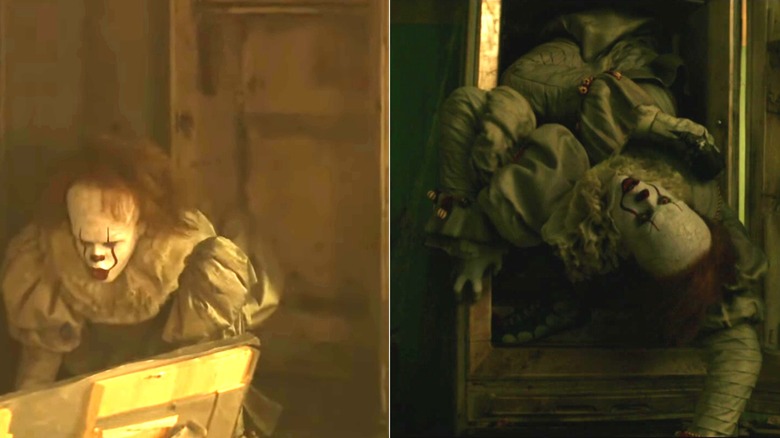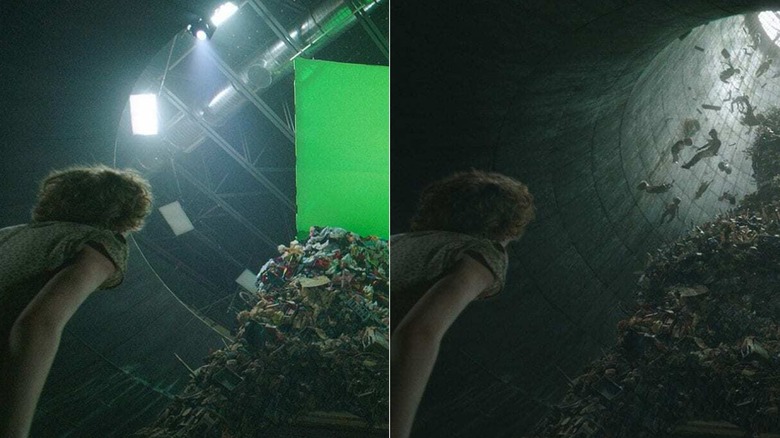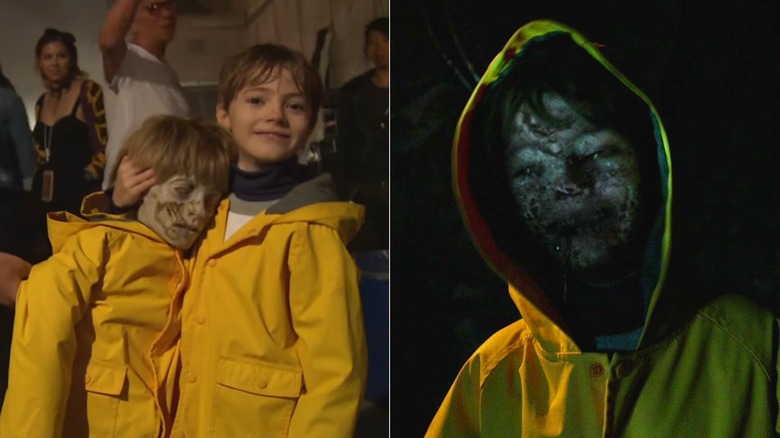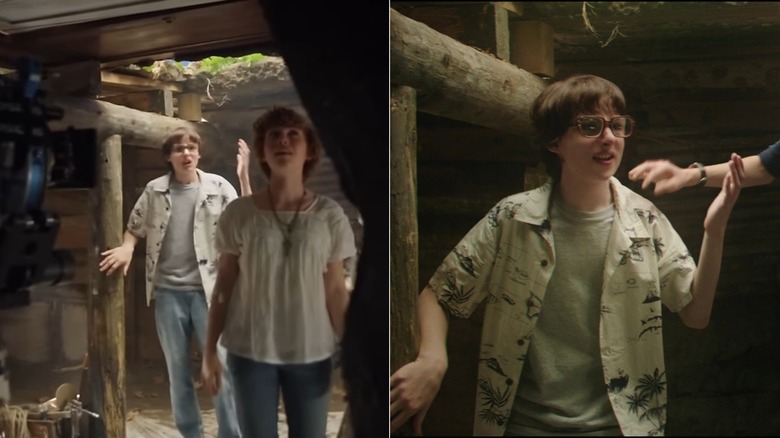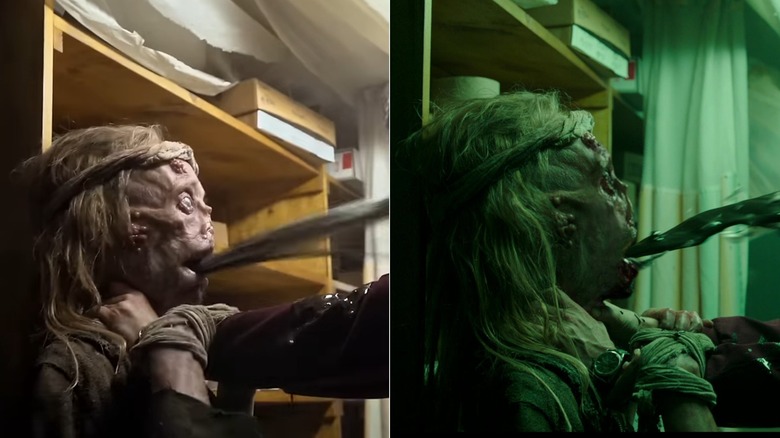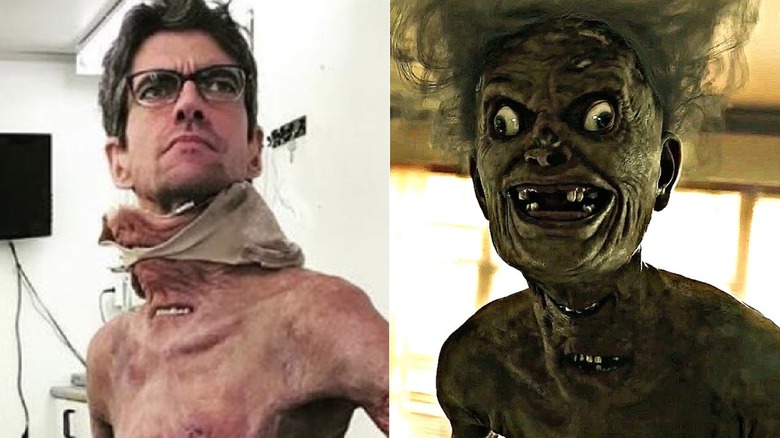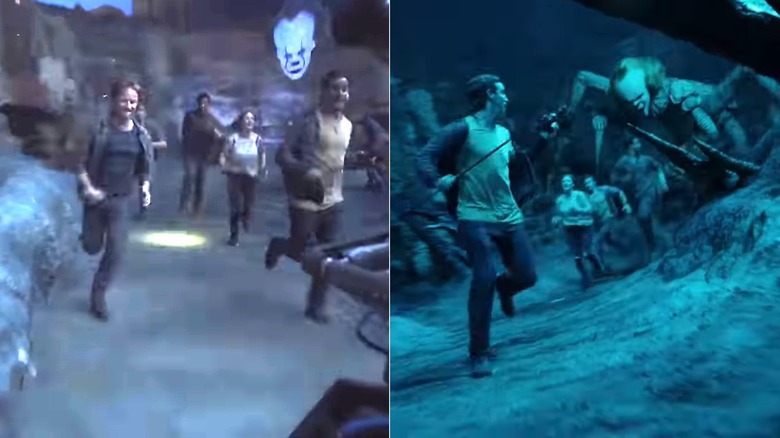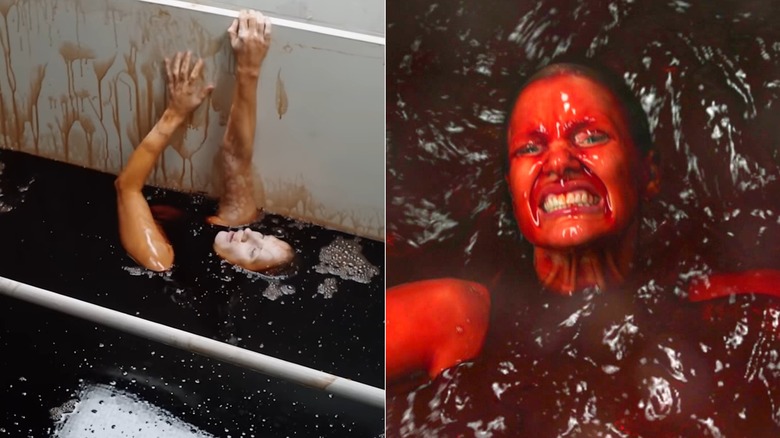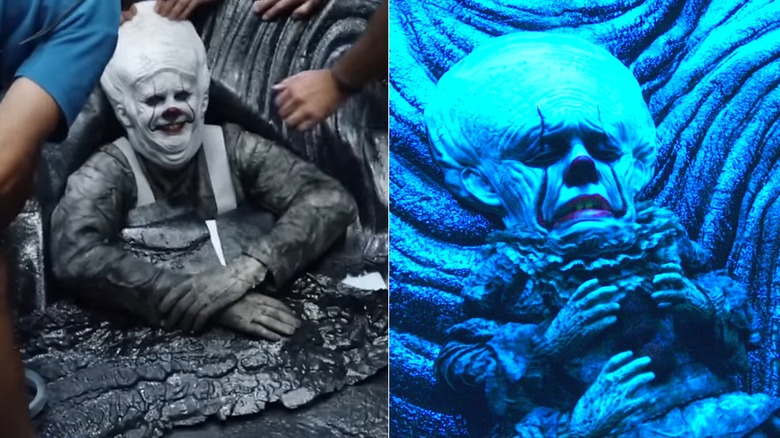What Stephen King's It Movies Look Like Without Special Effects
Moviegoers often complain — and rightfully so — about movies that use phony-looking CGI for moments that could have been achieved more convincingly with practical effects. Still, before you call out a film for its awful CGI, you want to first be certain that it's actually CGI you're looking at.
Fans and critics alike have called out the two movies based on Stephen King's novel "It" for their spotty use of CGI, but some of these moments involve less CGI than you might assume. From the shambling leper to the gallons of fake blood, there are plenty of effects in the "It" franchise that are almost entirely practical. And there are plenty more that used CGI to enhance what was already there. So while the "It" movies may use more a bit more or less computer trickery than other horror movies without special effects, you'll discover that some of the most iconic scenes from the "It" franchise may not look too different without CGI.
Bill Skarsgård can do Pennywise's lazy eye in real life
If you're wondering how Bill Skarsgård transformed into Pennywise, the answer is long hours in the makeup chair. Most of what you see in the final film is simply Skarsgård in prosthetic makeup. There is only CGI involved whenever Pennywise undergoes a transformation or his mouth does things that no person's mouth ought to do. And of course, his face is motion capture whenever his body is a giant spider-monster.
However, there is one creepy aspect of Pennywise that didn't require any makeup or CGI: the way his eyes seem to point in two different directions. Director Andy Muschietti knew early on that he wanted Pennywise to have that wall-eyed look, and he was planning on using VFX to create that effect. But it turned out that Bill Skarsgård could already make his eyes move that way on his own.
Looking back, Muschietti was astounded by the coincidence. "What are the chances? It's one in a million and he was cast already," he told Digital Spy. In the book "The World of It" by Alyse Wax, Muschietti recalled telling Skarsgård, "Good job, man. You just saved me hundreds of thousands of dollars."
Pennywise's fake teeth made the actor drool
Although Pennywise's "kill mouth" is CGI, the rest of the time you are looking at a practical effect. Bill Skarsgård had to wear various sets of fake teeth, including one with extra-large incisors (which the crew called "bunny teeth") and another set with multiple rows of tiny sharp teeth.
Barbara Muschietti, the film's producer and the director's sister, explained that these fake teeth had one side effect. "The teeth made him slobber like crazy," she shared in the documentary "The Summers of It — Chapter One: You'll Float Too." This was completely unintentional, but the filmmakers decided this fit Pennywise's character perfectly. Soon the makeup crew began augmenting Skarsgård's drool with a special substance they called "Slime," because the more drool the merrier.
His drool was so profuse that in one scene where Pennywise looms over Eddie (Jack Dylan Grazer), Skarsgård got it all over the actor. In "The Summers of It — Chapter One," Grazer said, "He drooled and he got it on my lips, and after the take, I thought it was my own drool, so I [got it in my mouth]." Luckily, Grazer was a good sport about it.
Bill Skarsgård spent hours up to his neck in water
After the crew was done filming the early sequence in "It" where Georgie (Jackson Robert Scott) goes down into the basement with a flashlight, the filmmakers flooded the set for the scene where Bill (Jaeden Martell) sees his dead brother and Pennywise. To film the latter scene, Bill Skarsgård climbed down into a trench that was filled with water. From there, he shot countless takes of Pennywise half-submerged in the water. "I have to give a shoutout to Bill for enduring that situation," director Andy Muschietti told GQ, "because he was submerged in horribly dirty water for, I don't know, four hours."
To create the effect of Pennywise springing out of the water, Skarsgård was pulled along a wire that rose out of the murk. In one behind-the-scenes clip, you can hear one crew member calling for a towel for Skarsgård. He certainly must have needed one; the water appears to be freezing.
The hair shooting out of the drain was filmed backward
The moment in "It" when the hair seems to leap out of the drain and wrap itself around Beverly (Sophia Lillis) was actually shot in reverse. Lillis told ScreenRant, "It looks like the hair is coming up, it's actually me trying to get out of the hair." This is confirmed by a behind-the-scenes clip, where you can see Lillis with strands of hair wrapped around her face while a crew member tugs on the opposite end of these strands, making them fall away from her face. This footage was then played backward in the final film.
When Beverly gets blasted by a stream of blood from the drain, that is also a practical effect. In an interview with Entertainment Weekly, Lillis recalled that the fake blood was sweet-tasting yet slippery. "I fell while sitting down," she said, "which I don't know how that's even physically possible." The torrent was so violent that the filmmakers needed to swap the actress out for a stunt double for the moment of impact.
Lillis told Entertainment Weekly, "They were going to use me for that but they decided they had to use a stunt double because the impact was like a whack with a baseball bat." After the initial spray of blood, Lillis stepped back in for the remainder of the scene, and no one was the wiser.
Skarsgård crawled through a projector screen
It took a bit of technical wizardry to create the scene where Pennywise appears to climb right out of an image cast by a film projector. In an interview with DGA Quarterly magazine, Andy Muschietti said, "We first shot the kids' performances in the garage location, reacting to a giant cardboard cutout of Bill." Afterward, they filmed the exact same scene again with Bill Skarsgård on a green-screen set, which was scaled down to make Pennywise seem gigantic. Muschietti explained, "We replicated every angle on that tiny set, with eyeline references for each kid using little sticks."
When the camera started rolling, Skarsgård crawled through a wooden frame meant to stand in for the projector screen (which couldn't have been comfortable). From there, he responded to the director's cues, since the other actors weren't present. Finally, the two scenes were combined digitally, creating one of the "It" franchise's most unsettling jumpscares.
Skarsgård didn't twist himself into knots for the fridge scene
For the scene where Pennywise unfurls his twisted body out of a refrigerator, Bill Skarsgård thankfully didn't need to do the same. He simply emerged from the fridge on a harness and let the animators do the twisting in post-production. Animation supervisor Yvon Jardel told ACM SIGGRAPH, "We kept Pennywise's head the same but completely animated the body." However, the filmmakers did enlist a contortionist to use as a reference for Pennywise's movements.
The filmmakers used a similar technique in "It: Chapter Two," when the characters see Stanley's (Wyatt Olef) body inside the fridge. The actor inserted his head into the fridge through an opening in the back; his crumpled body inside was a dummy. Later, when Stanley's head rolls off and sprouts spider legs, the crew used a lifelike prop head that was enhanced afterward with CGI.
Makeup designer Sean Sansom told Flickering Myth, "We basically put it on a stick and moved it around, mimicking what it would look like if it had legs." Whenever the spider-head attacked one of the characters, the prop head would be attached to the actor's head with bungee cords. So when you see Bill Hader's arms straining in the second film, he is pushing against a real physical prop.
The It crew built the cistern and extended it digitally
You may be wondering how much of Pennywise's lair is green screen. Not very much, as it turns out. The filmmakers built much of the set you see in the final film, from the sewer tunnels to the clown wagon. The sewer set had real water running through it (though thankfully it wasn't graywater).
Meanwhile, the pile of toys from Pennywise's victims stood about 30 feet high. The filmmakers merely extended the cistern and the heap of toys using VFX, to make them appear larger. They built a miniature model of the heap of toys that towered even higher, which was then digitally composited on top of the life-sized pile.
As for the floating bodies of dead kids, those were CGI. Animation supervisor Yvon Jardel told ACM SIGGRAPH, "We had to create a lot of poses of floating corpses, then work to chop off limbs randomly. It was both fun and creepy to do."
A life-sized doll was used for Georgie's corpse
You'd think that any kid would be traumatized after playing a character who is slaughtered by a shape-shifting clown and comes back to haunt his brother as a meat puppet. Not Robert Jackson Scott. Instead, he was rather casual about the whole thing.
In a behind-the-scenes clip from "The Summers of It — Chapter One: You'll Float Too," you can see Scott hugging a life-sized replica of himself. The doll looks just like him — except, of course, it has the rotting face of a corpse. "Hi," he tells the camera cheerfully. "I'm standing next to my dead self!" He added that he was excited to show it to Bill Skarsgård, whom he called "Pennywise." So kudos to this kid for not even flinching.
The second film de-aged the kids digitally
Most of the cast members were 12 and 13 years old when they portrayed the Losers' Club in the first movie. Yet when it came time to film the sequel, most of the kids were 15 and 16. So special effects company Lola VFX needed to use digital de-aging to make sure audiences wouldn't notice the difference.
Lola VFX typically works on de-aging adults, so using this effect on children was a challenge for them, because teenagers grow up so fast – sometimes so fast that the de-aging team couldn't keep up with them. Lola used techniques such as skin smoothing and shape-warping. Jeremy Ray Taylor (who played Ben) had gotten slimmer since the first film, so they needed to use CGI to round out his face. Meanwhile, Finn Wolfhard had gone through a growth spurt. Although he had been one of the shortest of the Losers in the first movie, he shot up to become one of the tallest, so the effects team needed to hide that and also change the shape of his jawline.
While the VFX team worked their magic, the actors needed to remember to act their characters' ages. In the documentary "The Summers of It — Chapter Two: It Ends," Andy Muschietti recalled, "I had to remind them that they were not 15."
The leper spewed real liquid on James Ransone
Remember the scene where Eddie (James Ransone) encounters the leper and gets a face-full of vomit? Despite fans' complaints that the leper scenes used too much CGI, this effect was actually not CGI (aside from one eye and presumably its tongue). In both films, the leper was played by actor Javier Botet, who wore a bodysuit and a mask.
For the part where the leper spews vomit, the effects team built a special vomit dummy with a tube running up its body to supply the puke. In "The Summers of It – Chapter Two: It Ends," producer Barbara Muschietti said of the director, "Andy loves vomit. He just wants to honor it." And honor it he did. Andy Muschietti had Ransone stand in the stream of fake vomit for a full five seconds.
According to Ransone, he almost passed out because all the fake puke in his face made it hard for him to breathe. In fact, this was how Ransone spent his final day on-set: on the receiving end of the leper's vomit. (Also, if you're wondering how actors fake puke in movies, we have a whole article just on this subject.)
The old hag was actually a man in a rubber suit
Another effect that many viewers have mistaken for pure CGI is the naked old lady. When Jessica Chastain filmed the scene in which Mrs. Kersh (Joan Gregson) transforms into a wild-eyed, witch-like hag, the actress didn't need to play off a CGI character that would be added later. To the contrary, this jump scare was largely a practical effect that left little to the imagination.
If you're wondering what this movie monster looks like without makeup, Mrs. Kersh was actually a man in a rubber suit. In fact, it's the same man who played the leper, the multi-talented Javier Botet. Behind-the-scenes photos shared by the actor show him wearing a bodysuit, complete with two mouths built into the old lady's neck. Seeing Botet in costume, pretending to knit or holding his mask under one arm like an astronaut helmet, will change how you view this scene in the movie.
Only the finishing touches in this scene were CGI. After filming the scenes with Mrs. Kersh, the VFX team took the actor's mask and created a digital model of it, so they could make her eyelids and lips move. Makeup designer Sean Sansom explained to Flickering Myth, "VFX only really got involved for the close-ups, as well as the bits where the creature needed to talk."
For the final battle, Pennywise was motion-capture
You may be relieved to know that Bill Skarsgård did not actually transform into a giant spider-clown to film the climax of "It: Chapter Two." In "The Summers of It — Chapter Two: It Ends," Skarsgård shared, "The whole ending of the movie is a motion-captured performance [from me]." He added, "It's always scary, I think, for an actor, when it's all in the hands of VFX, because you don't know how it's gonna look."
Skarsgård filmed all of spider-Pennywise's movements on a separate set, complete with little poles to stand in for the other actors so he would know how small they would look compared to Pennywise. Instead of clown makeup, Skarsgård only needed to wear a bunch of tiny dots painted on his face so the computer could record his facial movements.
Luckily, Skarsgård still got to participate in these sequences. While the actors were running in terror from a giant cardboard cutout of Pennywise's face, Skarsgård was back by the monitors, delivering his lines live into a microphone from offscreen.
Jessica Chastain took a dunk in fake blood
In what may well be the bloodiest scene in movie history, "It: Chapter Two" shows Beverly (Jessica Chastain) trapped in a bathroom stall as it floods with blood. Requiring 4500 gallons of fake blood, the sequence needed to be carefully planned, since if the filmmakers made a mistake they would need to drain away all the blood and start over.
Chastain wasn't happy with the director's original plans for the scene, saying it wouldn't be as scary if the blood only went up to her chest and then stopped. Muschietti had initially assumed the actress wouldn't be comfortable taking a dunk in fake blood that went over her head, but he underestimated Chastain's commitment. Chastain told him to bring on the blood. "Let's make 'Carrie' on steroids," she told Cinemablend.
Once she was up to her neck in the blood, however, Chastain began having second thoughts about her decision. "It was ... in your eyeballs, and it would get in your nose and your ears, and you just feel it all over you," she recalled in "The Summers of It — Chapter Two: It Ends." After she was done shooting, Chastain walked over to Andy and Barbara Muschietti and hugged them, making extra sure she got them all slimy with fake blood.
The effects team stapled Pennywise's head to the set
At the end of "It: Chapter Two," when Pennywise starts shrinking and dragging himself along the ground, that's not actually Bill Skarsgård. Instead, for this part the filmmakers substituted him with a child actor dressed like Pennywise, so he would look much smaller than the Losers' Club.
Once Pennywise arrives in his final resting place, it's Skarsgård again — or at least, Skarsgård's head. The rest of his body is a dummy designed so that Mike (Isaiah Mustafa) can reach inside his chest and pull out his heart. The filmmakers designed the set so that Skarsgård could be buried in it until only his head was visible. In "The Summers of It – Chapter Two: It Ends," Andy Muschietti recalled, "I took Bill to the limit. He was buried in a hole. His whole body was inside the structure. So [the only thing] that he could move was his [face]."
Finally, the crew stapled the top of his Pennywise mask (which they called "Pancake Head") to the set, in order to make it seem like Pennywise was melting into the rock. Hopefully, seeing Pancake Head without any special effects will make this moment a little less nightmare-inducing.
